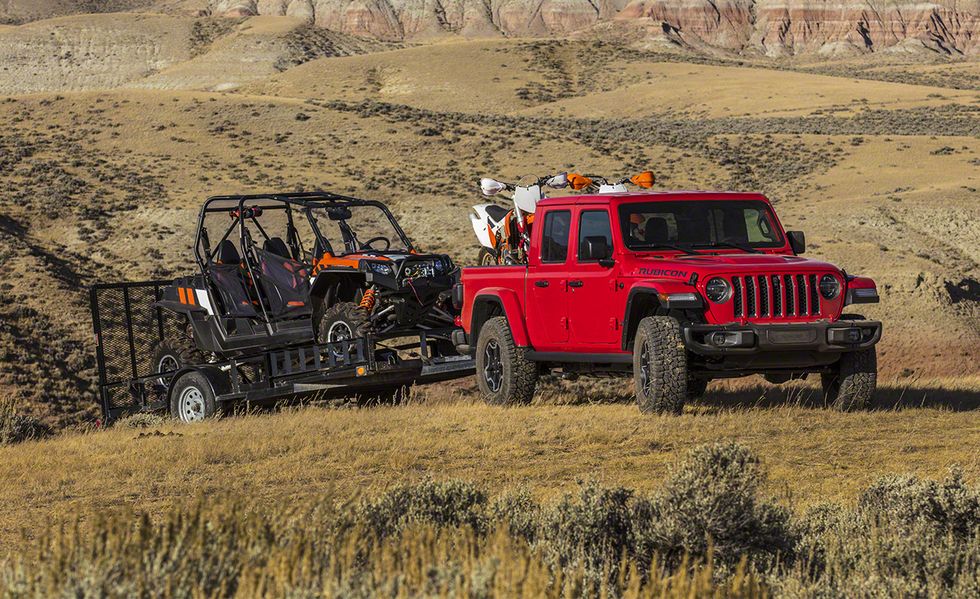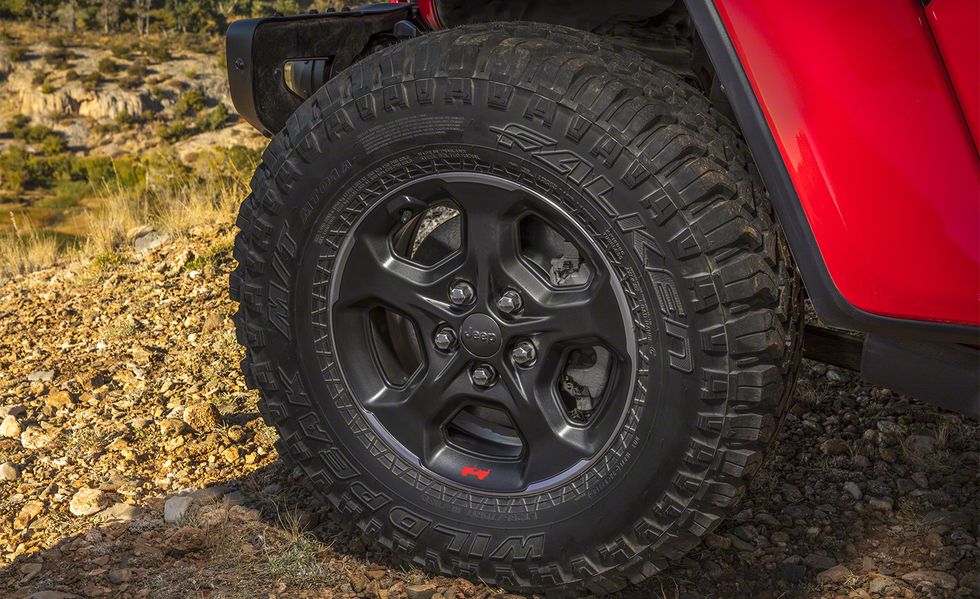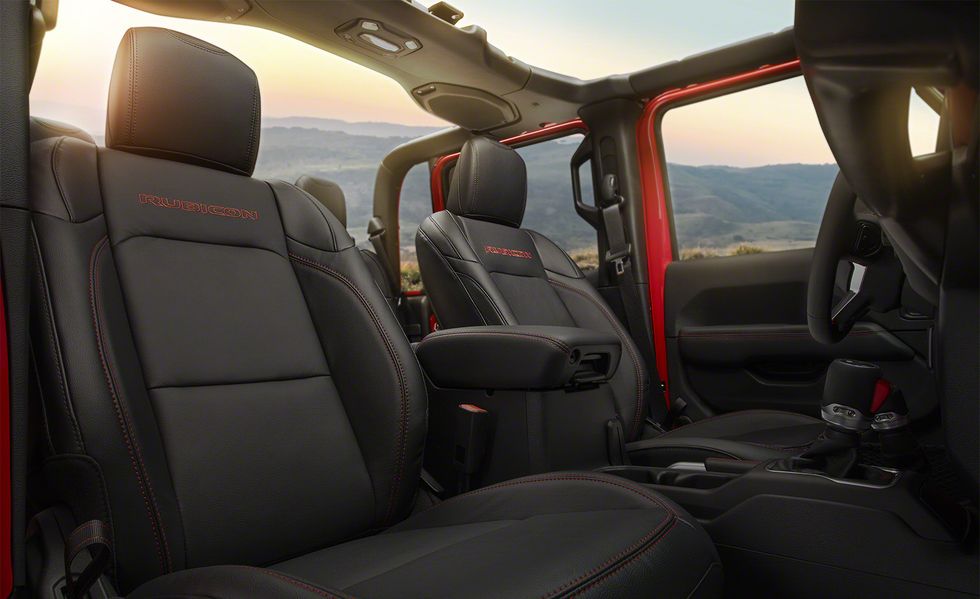The 2020 Jeep Gladiator JT pickup is easily one of the most-anticipated vehicles—and worst-kept secrets—of the year. Fully functional Jeep Gladiator mules have been prowling the roads of southeastern Michigan and other locales for nearly two years now, but their three-box profile revealed few of the significant details of the new pickup's design. While the Jeep cognoscenti maintained that the new pickup would be essentially a modern Scrambler—that is, a Wrangler with a bed bolted onto the back—Jeep had more ambitious plans.
Jeep knew that while a Wrangler with a bed would certainly find its share of fans, a real mid-size truck, one that could compete with the latest off-road offerings in the suddenly revitalized segment, would pay long-term dividends for the brand. That meant offering serious towing and payload capacity without compromising any of its off-road capability, and Jeep brings it: Rated to tow a maximum of 7650 pounds, the Toledo-built 2020 Gladiator Sport with the V-6 and eight-speed automatic turning 4.10:1 axles surpasses the 3500-pound towing capacity of the most capable Jeep Wrangler JL by more than two tons. When equipped with a six-speed manual, also in Sport guise, the Gladiator's five-foot bed is rated to haul 1600 pounds, topping the JL's capacity by more than 700 pounds. That's 2650 pounds more robust than the 5000-pound tow rating of the Chevrolet Colorado ZR2, a vehicle Jeep considers to be a direct competitor to the Gladiator. And it's 650 more pounds of tow capability than the upcoming 2019 Ford Ranger's stated max of 7000 pounds. (To be fair, non-ZR2 Colorados can tow up to 7000 pounds when equipped with the 3.6-liter V-6 and 7700 pounds with the 2.8-liter diesel engine, but these models lack the off-road hardware and chutzpah of the ZR2 and the Gladiator.) It's also worth noting that, true to its mission statement, Jeep isn't even offering a rear-drive version of the Gladiator.
Substantial Changes from Wrangler to Gladiator
Jeep claims the Gladiator shares less than 50 percent of its parts with the Wrangler JL. While numerous factors play into reengineering the Wrangler's DNA for work as well as play, the basic building blocks consist of an entirely new frame and Dana 44 live axles front and rear. The frame measures 30.6 inches longer than that which underpins the current Wrangler JL four-door and gives the Gladiator a 137.3-inch wheelbase, a considerable 19.9 inches longer than that of the Wrangler JL 4-door. While the Wrangler's five-link coil-spring suspension design is used up front, at the rear is a Gladiator-exclusive five-link design with forged steel trailing arms and a Panhard rod. The setup positions the trailing arms under the frame rails, while the rear gas-tuned dampers face forward to provide consistent damping for ride comfort and load management. The suspension is tuned to provide a balance of on-road handling and off-road capability as well as a comfortable ride with or without cargo. It's no secret that a longer wheelbase can provide a better ride, and Jeep claims that the positioning of the bed's centerline slightly aft of the rear axle centerline contributes to improved ride quality when loaded with cargo.
When the Gladiator arrives in the second quarter of 2019, it will be equipped with the Wrangler's 3.6-liter V-6 engine mated to the D478 six-speed manual transmission as standard equipment. Good for 285 horsepower and 260 lb-ft of torque, the Pentastar V-6 is a known quantity if not a groundbreaking one. An eight-speed automatic is optional. At this point, Jeep has no intention of offering the Wrangler's eTorque inline-four in the Gladiator.
In 2020, we'll see the arrival of the 3.0-liter EcoDiesel V-6 engine to the Gladiator lineup. Rated at 260 horsepower and 442 lb-ft of torque, it comes exclusively with the eight-speed automatic. Compared to the unit used in the Ram 1500 Classic, Jeep notes, this version features a refined turbocharger with a low-friction bearing, low-friction pistons, optimized injectors, and a few additional tweaks. A low pressure water-cooled exhaust-gas recirculation (EGR) valve improves emissions and fuel economy.
Fraternal Twin
While the body section and interior are nearly identical to the Wrangler's, the Gladiator wears a redesigned grille, hood, and front fenders. In order to earn that impressive tow rating, Jeep had to modify the fascia with wider slats and add a larger 800-watt electric fan. The bed is constructed of steel with four load-floor crossmembers while the tailgate is aluminum. One neat feature is the tailgate's ability to lock in a partially opened state where the top edge sits at the same height as the wheel wells to create three-point base for hauling sheet goods such as a four-by-eight-foot sheet of plywood. Integrated tie-downs, bed lighting, an available spray-in bedliner, and a bed power source add to the convenience. The spare tire mounts under the bed and can handle up to a 35-inch tire. Additional aluminum bits include the easily removable doors and door hinges, the hood, fender flares, and windshield frame–and, yes, it folds just like the Wrangler JL's.
Hardtop models come with a three-piece removable top and manual sliding rear window. The front panels are identical to the Wrangler's Freedom top, but the Gladiator employs a single removable panel over the rear passenger area to ensure the sunburns are distributed democratically. Buyers interested in getting a serious tan can opt for the Sunrider soft top which easily folds away to provide the classic open-air Jeep experience.
The interior closely mimics that of the Wrangler, with exposed bolt heads, a weather-protected push-button starter, a full complement of grab handles, mesh storage nets, phone cubbies, and available features such as heated seats and a heated steering wheel. Front passengers get their choice of a two standard USB ports and a single USB-C port, while rear passengers have access to an additional two ports; an available 115-volt AC outlet can power home electronics.
Rear seating is specific to the Gladiator. The foldable seats feature a seatback that can be locked in place to protect valuables stored behind them, and an additional lockbox resides underneath the seat base for added security. Jeep rightfully claims segment-leading rear-seat legroom, bettering the Colorado Crew Cab's 35.8 inches and the Honda Ridgeline's 36.7 inches with 38.0 inches of legroom. An additional Gladiator exclusive is an available portable wireless speaker, located behind the rear seat. When nestled in its base, it not only charges but contributes to the overall sound stage; an optional subwoofer is also available.
Four Off-Road-Ready Models
Like the Wrangler, the Gladiator will be available in four trims: Sport, Sport S, Overland, and Rubicon. Sport and Overland models come with the Command-Trac four-wheel-drive system featuring a two-speed transfer case with a 2.72:1 low-range gear ratio, and Dana 44 front and rear axles with 3.73:1 gears. A Trac-Lok limited-slip rear diff is available. With the standard 31-inch tires, this translates into a 40.8-degree approach angle, an 18.4-degree breakover angle, a 25.0-degree departure angle, and 10.0 inches of ground clearance.
The Rubicon is the ultimate off-roader. Featuring 33-inch tires (Jeep says 35s will fit without modification) and the Rock-Trac 4x4 system with standard electronically locking 4.10:1 axles, the Rubicon achieves an impressive low-range ratio of 4.00:1. That converts to an overall first-gear ratio of 84.1:1 with the manual transmission and 77.2:1 with the automatic. Essentially, this means the ability to keep a low vehicle speed while maintaining plenty of torque for difficult situations such as rock climbing. The Rubicon model adds an approximate 2.0-inch lift, 33-inch tires, and high-pressure gas-charged Fox Shox monotube dampers with hydraulic rebound stops, the Rubicon clocks in with a 43.4-degree approach angle, 20.3-degree breakover angle, 26.0-degree departure angle, 11.1 inches of ground clearance, and 30 inches of water-fording capability.
Both get a complement of skid plates to protect the fuel tank, transfer case, and automatic transmission, and Rubicon models feature heavy-gauge tubular steel rock rails for the body and bed corners to minimize damage while still allowing for plenty of off-road fun.
The return of the Jeep pickup has been a long time coming, and the market for mid-size pickups hasn't been this lively since the 1980s. Price, of course, will play a large role in the Gladiator's success or lack thereof, but judging by the seemingly insatiable demand for the Wrangler, the Gladiator will receive a warm welcome. That it can actually justify its existence with genuine utility and capabilities is just a value-added bonus.

Andrew Wendler brings decades of wrenching, writing, and editorial experience with numerous outlets to Car and Driver. His work has appeared in numerous publications, including Car and Driver, Esquire, Forbes, Hot Rod, Motor Trend, MPH, MSN, and Popular Mechanics, among others. A Rust Belt native and tireless supporter of the region, he grew up immersed in automotive, marine, and aviation culture. A lifetime of hands-on experience and a healthy dose of skepticism provide him the tools to deliver honest and informative news, reviews, and editorial perspective. Of note, he once won a $5 bet by walking the entire length of the elevated People Mover up track that encircles downtown Detroit.


















